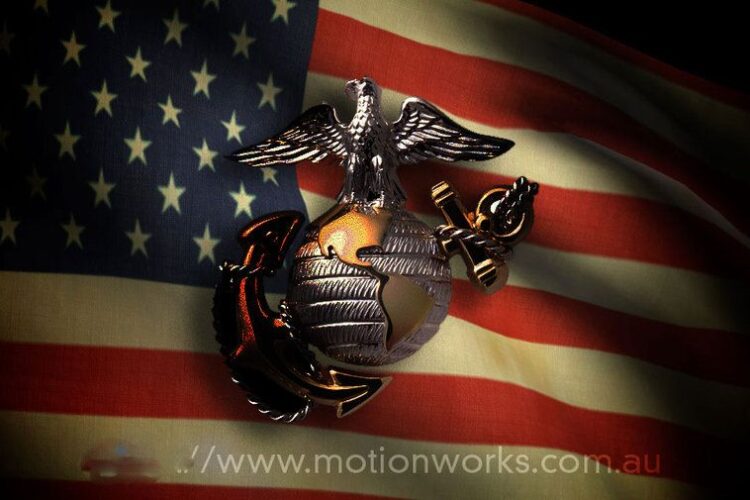
I. Introduction to the Marine Corps
* Overview of the Marine Corps’ history and purpose
* Explanation of the Marine Corps’ role in the U.S. military
II. Marine Corps Training and Preparation
* Description of basic training and job-specific training
* Explanation of the physical and mental demands of Marine Corps training
III. Marine Corps Structure and Organization
* Overview of the Marine Corps’ chain of command
* Explanation of the various units and divisions within the Marine Corps
IV. Marine Corps Deployment and Missions
* Discussion of the types of missions the Marine Corps is tasked with
* Explanation of the deployment process and where Marines may be stationed
V. Marine Corps Equipment and Technology
* Overview of the weapons and vehicles used by the Marine Corps
* Explanation of the Marine Corps’ use of cutting-edge technology
VI. Marine Corps Culture and Traditions
* Discussion of the Marine Corps’ unique culture and traditions
* Explanation of the importance of esprit de corps in the Marine Corps
VII. Career Opportunities in the Marine Corps
* Overview of the different career paths available in the Marine Corps
* Explanation of the benefits and challenges of a career in the Marine Corps
Welcome to our exploration of the United States Marine Corps! We’re thrilled to have you here as we delve into the fascinating world of the Marine Corps. In this first section, we’ll provide a captivating introduction to the Marine Corps’ history, purpose, and its significant role within the U.S. military.
### The Birth of a Legendary Force
The Marine Corps was established on November 10, 1775, during the American Revolution by the Continental Congress. Its primary mission was to serve as a naval infantry unit, conducting amphibious operations and providing security for American naval assets. Since then, the Marine Corps has evolved into a formidable force, renowned for its courage, discipline, and combat readiness.
### The Marine Corps’ Purpose and Place in the U.S. Military
The Marine Corps is one of the five branches of the U.S. military, operating under the Department of the Navy. Its primary role is to provide rapid-response capability, with a focus on securing and defending advanced naval bases and other land operations to support naval campaigns. The Marine Corps is often the first U.S. military force on the ground in times of crisis, earning them the nickname “America’s 911 Force.”
### A Distinctive Culture and Identity
The Marine Corps has cultivated a unique culture and identity that sets it apart from other military branches. Its ethos is centered around its core values of Honor, Courage, and Commitment, which serve as a moral compass for every Marine. The Corps also takes great pride in its rich history and traditions, which help forge a strong esprit de corps among its members.
### Embracing Challenges and Adapting to Change
Throughout its history, the Marine Corps has faced numerous challenges and adversities, from the shores of Tripoli to the battlefields of World War II, Korea, Vietnam, and the Global War on Terror. Despite these challenges, the Marine Corps has consistently adapted to new threats, technologies, and mission requirements. This adaptability and resilience have been crucial to the Corps’ continued success and relevance in an ever-changing world.
### Engaging with Communities and Promoting Public Service
The Marine Corps is deeply committed to engaging with local communities and inspiring the next generation of public servants. The Corps participates in various outreach programs, such as the Young Marine program, which aims to instill core values, develop leadership skills, and promote physical fitness among America’s youth.
In summary, the Marine Corps is a vital and dynamic component of the U.S. military, with a rich history, distinct culture, and unwavering commitment to protecting and defending American interests at home and abroad. In the following sections, we’ll delve deeper into the training, structure, deployments, equipment, traditions, and career opportunities that make the Marine Corps a truly exceptional organization.
Marine Corps Training and Preparation
Now that you have a better understanding of the Marine Corps’ history and purpose let’s explore the rigorous training and preparation that every Marine undergoes to become a formidable and disciplined force. From basic training to job-specific instruction, the physical and mental demands of Marine Corps training are unparalleled in their intensity and comprehensiveness.
II. Marine Corps Training and Preparation: What to Expect
So, you’re considering joining the Marine Corps, huh? Well, you’re in for quite the journey. The Marine Corps is known for its rigorous training and high standards, but don’t let that scare you off. With hard work and determination, you can make it through and come out the other side a proud and capable Marine. Here’s what you can expect from the training and preparation process:
Basic Training: The First Step
Every Marine’s journey begins with basic training, also known as “boot camp.” This 13-week program is designed to turn recruits into Marines, and it covers everything from physical fitness to weapons handling to Marine Corps history and values. It’s a challenging and intense experience, but it’s also incredibly rewarding. You’ll learn a lot about yourself and what you’re capable of, and you’ll form close bonds with your fellow recruits that will last a lifetime.
Job-Specific Training: Learning Your Role
After basic training, you’ll move on to job-specific training, also known as “MOS school” (MOS stands for Military Occupational Specialty). This is where you’ll learn the skills and knowledge needed for your specific job in the Marine Corps. There are dozens of different MOSs to choose from, ranging from infantry and artillery to logistics and communication. No matter what MOS you choose, you can expect top-notch training and the opportunity to become an expert in your field.
Physical and Mental Demands: Preparing for the Challenges Ahead
Marine Corps training is both physically and mentally demanding. You’ll be pushed to your limits and beyond, but that’s all part of the process. The Marine Corps needs confident, capable, and resilient Marines who can handle whatever comes their way. That’s why the training is so tough – to prepare you for the challenges you’ll face in the fleet. Don’t be afraid to ask for help or seek support when you need it. Your fellow Marines and instructors are there to help you succeed.
A Few Tips for Making it Through Training
- Stay physically fit: The better shape you’re in, the easier time you’ll have with the physical demands of training.
- Pay attention and ask questions: You’ll be learning a lot of new information, so it’s important to stay engaged and ask questions if you’re unsure about something.
- Support your fellow Marines: You’re all in this together, so look out for each other and offer support when needed.
- Take care of yourself: Make sure to get enough sleep, eat well, and take care of your mental health. Training is a marathon, not a sprint.
The Marine Corps training and preparation process is challenging, but it’s also incredibly rewarding. With hard work and determination, you can make it through and come out the other side a proud and capable Marine. Good luck!
III. Marine Corps Structure and Organization
The Marine Corps is a unique branch of the military, with its own distinct structure and organization. At the top of the chain of command is the Commandant of the Marine Corps, who is responsible for overseeing the training, readiness, and mission fulfillment of all Marines.
One of the most important aspects of the Marine Corps’ structure is its strict adherence to the chain of command. This means that orders and instructions flow down from the Commandant through various levels of leadership, ensuring that all Marines understand their roles and responsibilities.
At the unit level, the Marine Corps is organized into a variety of different units and divisions. The smallest unit is the squad, which typically consists of 13 Marines led by a squad leader. A group of squads forms a platoon, which is led by a platoon commander. Several platoons make up a company, which is commanded by a captain. A battalion is made up of several companies, and is led by a lieutenant colonel.
One of the most well-known units in the Marine Corps is the Marine Expeditionary Unit (MEU). A MEU is a quick-reaction force made up of ground, air, and logistics elements, and is capable of responding to a variety of different missions around the world.
In addition to MEUs, the Marine Corps also has a number of other specialized units, including the Marine Raiders, the Marine Corps Special Operations Command (MARSOC), and the Marine Air-Ground Task Force (MAGTF). These units are trained to conduct specialized missions, such as reconnaissance, counter-terrorism, and direct action.
Another important aspect of the Marine Corps’ structure is its emphasis on esprit de corps. This is the sense of pride and loyalty that Marines feel towards their unit and the Corps as a whole. This sense of esprit de corps is fostered through a variety of traditions, such as the wearing of the iconic Marine Corps dress blue uniform, and the performance of the Marine Corps Hymn.
It’s also important to note that the Marine Corps has a strong emphasis on leadership and officer development. The Marine Corps Officer Candidates School (OCS) is a rigorous 10-week program that is designed to test the physical, mental, and emotional limits of its candidates. Those who successfully complete OCS are commissioned as second lieutenants in the Marine Corps.
In conclusion, the Marine Corps has a unique structure and organization that is designed to ensure the readiness and mission fulfillment of its Marines. From the strict adherence to the chain of command, to the emphasis on esprit de corps and leadership development, the Marine Corps is a highly-disciplined and effective branch of the military.
Marine Corps Structure and Organization
The Marine Corps is a unique branch of the military, with its own distinct structure and organization. At the top of the chain of command is the Commandant of the Marine Corps, who is responsible for overseeing the training, readiness, and mission fulfillment of all Marines.
Chain of Command
One of the most important aspects of the Marine Corps’ structure is its strict adherence to the chain of command. This means that orders and instructions flow down from the Commandant through various levels of leadership, ensuring that all Marines understand their roles and responsibilities.
Units and Divisions
At the unit level, the Marine Corps is organized into a variety of different units and divisions. The smallest unit is the squad, which typically consists of 13 Marines led by a squad leader. A group of squads forms a platoon, which is led by a platoon commander. Several platoons make up a company, which is commanded by a captain. A battalion is made up of several companies, and is led by a lieutenant colonel.
Marine Expeditionary Unit (MEU)
One of the most well-known units in the Marine Corps is the Marine Expeditionary Unit (MEU). A MEU is a quick-reaction force made up of ground, air, and logistics elements, and is capable of responding to a variety of different missions around the world.
Specialized Units
In addition to MEUs, the Marine Corps also has a number of other specialized units, including the Marine Raiders, the Marine Corps Special Operations Command (MARSOC), and the Marine Air-Ground Task Force (MAGTF). These units are trained to conduct specialized missions, such as reconnaissance, counter-terrorism, and direct action.
Esprit de Corps
Another important aspect of the Marine Corps’ structure is its emphasis on esprit de corps. This is the sense of pride and loyalty that Marines feel towards their unit and the Corps as a whole. This sense of esprit de corps is fostered through a variety of traditions, such as the wearing of the iconic Marine Corps dress blue uniform, and the performance of the Marine Corps Hymn.
Leadership Development
It’s also important to note that the Marine Corps has a strong emphasis on leadership and officer development. The Marine Corps Officer Candidates School (OCS) is a rigorous 10-week program that is designed to test the physical, mental, and emotional limits of its candidates. Those who successfully complete OCS are commissioned as second lieutenants in the Marine Corps.
Conclusion
The Marine Corps has a unique structure and organization that is designed to ensure the readiness and mission fulfillment of its Marines. From the strict adherence to the chain of command, to the emphasis on esprit de corps and leadership development, the Marine Corps is a highly-disciplined and effective branch of the military.
### Marine Corps Deployment and Missions
Once you have completed your training and are a fully-fledged Marine, it’s time to get to work. The Marine Corps is tasked with a variety of missions, and as a member of this elite force, you could find yourself deployed to a number of different locations around the world.
#### Types of Missions
The Marine Corps is a versatile branch of the military, and as such, Marines can be called upon to carry out a wide range of missions. Some of the most common types of missions that the Marine Corps is tasked with include:
* **Amphibious assaults:** The Marine Corps is known for its ability to conduct amphibious assaults, or attacks on enemy territory from the sea. This type of mission requires a high level of coordination and skill, as Marines must be able to navigate both the water and the land in order to successfully complete their objective.
* **Security operations:** Marines may be called upon to provide security for important installations, both at home and abroad. This could include providing security for embassies, military bases, or other sensitive locations.
* **Disaster relief:** In times of natural disasters, the Marine Corps is often called upon to provide assistance. Marines may help with search and rescue efforts, provide medical care, or distribute supplies to those in need.
* **Counterinsurgency and counterterrorism:** The Marine Corps plays a key role in the U.S. military’s efforts to combat insurgency and terrorism. Marines may be called upon to conduct raids, ambushes, and other offensive operations against enemy forces.
#### The Deployment Process
When it comes time for deployment, Marines will go through a series of steps to prepare. This process typically includes:
1. **Pre-deployment training:** Marines will undergo training specific to the mission and location they will be deployed to. This training will help ensure that Marines are physically and mentally prepared for the challenges they will face.
2. **Medical screening:** Marines will receive a medical screening to ensure that they are in good health and able to deploy. This may include vaccinations, physical exams, and dental checkups.
3. **Packing and preparation:** Marines will pack their gear and prepare for deployment. This may include reviewing mission plans, studying the local culture and language, and ensuring that they have all the necessary equipment.
4. **Deployment:** Marines will deploy to their assigned location, where they will carry out their mission. The length of deployment can vary, depending on the mission and other factors.
#### Where Marines May Be Stationed
Marines may be stationed at bases in the United States, as well as overseas. Some of the most common locations for Marine Corps deployment include:
* **Japan:** The Marine Corps has a significant presence in Japan, with several bases located on the island of Okinawa.
* **South Korea:** The Marine Corps also has a presence in South Korea, where they work to maintain stability on the Korean peninsula.
* **The Middle East:** The Marine Corps has been heavily involved in operations in the Middle East, including the wars in Iraq and Afghanistan.
* **Africa:** The Marine Corps has also been involved in operations in Africa, providing support to U.S. and African forces fighting extremist groups.
Being a Marine means being ready to deploy at a moment’s notice, and being willing to serve wherever you are needed. It’s a challenging and rewarding career, and one that will take you to new and exciting places.
—
Please note that the above text is for informational purposes only and should not be considered as official Marine Corps policy or guidelines.
Marine Corps Equipment and Technology: A Closer Look
As one of the five branches of the U.S. military, the Marine Corps is known for its ability to rapidly deploy and respond to crises around the world. To accomplish its mission, the Marine Corps relies on a variety of weapons, vehicles, and cutting-edge technology. In this section, we will take a closer look at the equipment and technology used by the Marine Corps, and explore how it helps them carry out their duties.
Weapons of the Marine Corps
Marines are trained to use a wide range of weapons, including firearms, explosives, and knives. Some of the most common weapons used by the Marine Corps include the M4 carbine, the M16A4 rifle, and the M249 machine gun. The Marine Corps also uses a variety of grenades, including fragmentation grenades, smoke grenades, and stun grenades. In addition, Marines are trained in the use of shoulder-fired missiles, such as the Javelin and TOW missiles, for use against armored vehicles and other targets.
Vehicles of the Marine Corps
The Marine Corps operates a variety of vehicles, including armored personnel carriers, tanks, and amphibious vehicles. The Corps’ amphibious vehicles, such as the Amphibious Assault Vehicle (AAV) and the Expeditionary Fighting Vehicle (EFV), are designed to transport Marines from ship to shore and provide fire support during beach assaults. The Corps also operates a variety of aircraft, including helicopters, transport planes, and fighter jets. These aircraft are used for a variety of missions, including transporting troops and supplies, providing close air support, and conducting reconnaissance.
Cutting-Edge Technology
The Marine Corps is at the forefront of military technology, and is constantly seeking new ways to improve its capabilities. One example of this is the use of unmanned aerial vehicles (UAVs) for reconnaissance and targeting. UAVs, also known as drones, can fly for extended periods of time and gather valuable intelligence on enemy positions and movements. The Marine Corps is also exploring the use of 3D printing to quickly produce spare parts and other equipment in the field. This can help reduce the logistical burden of supplying troops with the equipment they need, and allow them to be more flexible and responsive in dynamic situations.
The Importance of Equipment and Technology
The equipment and technology used by the Marine Corps plays a critical role in its ability to carry out its mission. Modern weapons and vehicles allow Marines to engage the enemy at longer ranges and with greater precision, while cutting-edge technology helps them gather intelligence and make informed decisions. By staying at the forefront of military technology, the Marine Corps is able to maintain its edge over potential adversaries and ensure the security of the United States.
Conclusion
The Marine Corps is a formidable branch of the U.S. military, known for its rapid deployment and ability to respond to crises around the world. The equipment and technology used by the Marine Corps plays a critical role in its ability to carry out its mission, and the Corps is constantly seeking new ways to improve its capabilities. From firearms and explosives to armored vehicles and drones, the Marine Corps has a wide range of tools at its disposal, allowing it to quickly and effectively respond to any challenge it may face.
VI. Marine Corps Culture and Traditions: A Proud and Time-Honored Heritage
The Marine Corps is known for its rich culture and storied traditions, which have been carefully developed and maintained over the corps’ proud history. From the iconic dress uniforms to the revered rituals, the Marine Corps instills in its members a deep sense of pride, unity, and esprit de corps.
A Unique Esprit de Corps
One of the most defining aspects of Marine Corps culture is the intense sense of camaraderie and shared purpose that exists among its members. This esprit de corps is built on a foundation of shared hardships, challenges, and triumphs, and it fosters a deep loyalty and commitment to one’s fellow Marines.
This sense of unity is further strengthened by the Marine Corps’ emphasis on tradition and ritual. From the intricate process of raising and lowering the flag at sunrise and sunset, to the solemn ceremony of retreat, these rituals serve to reinforce the bonds between Marines and to remind them of the sacrifices and achievements of those who have come before them.
Dress Uniforms: A Symbol of Pride and Professionalism
The Marine Corps’ dress uniforms are among the most recognized and respected in the world. The iconic blue and red uniforms, with their gleaming buttons, shiny black shoes, and distinctive covers, are a source of great pride for Marines and serve as a powerful symbol of the corps’ professionalism and dedication.
The uniforms also play an important role in reinforcing the Marine Corps’ culture of tradition and heritage. From the intricate embroidery on the collar of the dress blue uniform, to the ornate design of the white gloves, every detail has been carefully considered and carries with it a deep meaning and significance.
Honoring the Past, Shaping the Future
The Marine Corps’ culture and traditions are not just about looking back, however. They also play a critical role in shaping the future of the corps and its members. By instilling in Marines a deep sense of pride, unity, and purpose, the Marine Corps is able to create a powerful and cohesive force that is capable of meeting any challenge.
Furthermore, the Marine Corps’ emphasis on tradition and heritage serves as a constant reminder of the sacrifices and achievements of those who have come before. This reminder serves to inspire and motivate Marines to uphold the highest standards of conduct and to strive for excellence in all that they do.
Joining the Marine Corps: A Life-Changing Decision
For those considering a career in the Marine Corps, it is important to understand that this is a life-changing decision. The Marine Corps is not just a job, it is a way of life, with its own unique culture, traditions, and expectations.
However, for those who are willing to embrace the challenges and sacrifices that come with being a Marine, the rewards are great. From the sense of pride and camaraderie that comes from being a part of the Marine Corps family, to the opportunity to serve one’s country and make a difference in the world, a career in the Marine Corps can be a truly fulfilling and meaningful experience.
VII. Career Opportunities in the Marine Corps: An Exciting and Rewarding Path
The Marine Corps offers a wide range of career opportunities, each with its own unique set of challenges, benefits, and rewards. Whether you’re interested in technology, engineering, logistics, aviation, or healthcare, the Marine Corps has a place for you.
A Diverse Range of Career Paths
Some of the most popular career paths in the Marine Corps include:
- Ground Combat: As a member of a ground combat unit, you’ll be responsible for engaging in direct combat with the enemy, using a variety of weapons and tactics. This career path is physically demanding and requires a high level of mental toughness and discipline.
- Logistics: If you’re interested in supply chain management, transportation, or procurement, a career in logistics may be for you. In this role, you’ll be responsible for ensuring that Marines have the supplies and equipment they need to complete their missions.
- Aviation: If you have a passion for flying, a career in Marine Corps aviation may be the perfect fit. As a pilot, you’ll fly some of the most advanced aircraft in the world, and you’ll be responsible for providing air support to ground troops.
- Engineering: As a Marine engineer, you’ll be responsible for designing, building, and maintaining the infrastructure that supports Marine Corps operations. This can include everything from bridges and roads to buildings and airfields.
- Healthcare: If you’re interested in healthcare, the Marine Corps offers a variety of career paths, including roles as a physician, nurse, or medical laboratory scientist. In these roles, you’ll provide critical medical care to Marines, both in garrison and in combat zones.
The Benefits of a Career in the Marine Corps
There are many benefits to pursuing a career in the Marine Corps, including:
- Education: The Marine Corps offers a variety of education benefits, including tuition assistance and the Post-9/11 GI Bill, which can help you pay for college or graduate school.
- Training: The Marine Corps provides extensive training in a variety of fields, giving you the skills and knowledge you need to succeed in your career.
- Leadership Opportunities: As a Marine, you’ll have the opportunity to lead and mentor others, both in combat and in garrison. This can be a rewarding and fulfilling experience, and it can help you develop valuable leadership skills that will serve you well throughout your career.
- Travel: The Marine Corps offers opportunities to travel and see the world, both in the United States and abroad. This can be an exciting and enriching experience, and it can help you broaden your horizons and develop a greater understanding of different cultures and ways of life.
The Challenges of a Career in the Marine Corps
Of course, a career in the Marine Corps is not without its challenges. Some of the most significant challenges include:
- Physical Demands: The Marine Corps is a physically demanding organization, and you’ll need to be in good physical shape to succeed. This may require you to make significant changes to your lifestyle, including eating a healthy diet and exercising regularly.
- Mental Demands: The Marine Corps can also be mentally demanding, and you’ll need to be able to handle stress, pressure, and uncertainty. This may require you to develop coping strategies, such as meditation, mindfulness, or relaxation techniques.
- Deployment: As a Marine, you may be required to deploy to combat zones or other hostile environments. This can be a challenging and stressful experience, and it may require you to be away from your family and friends for extended periods of time.
Despite these challenges, a career in the Marine Corps can be an exciting and rewarding experience. With its unique culture, traditions, and opportunities, the Marine Corps offers a path unlike any other.










Comments